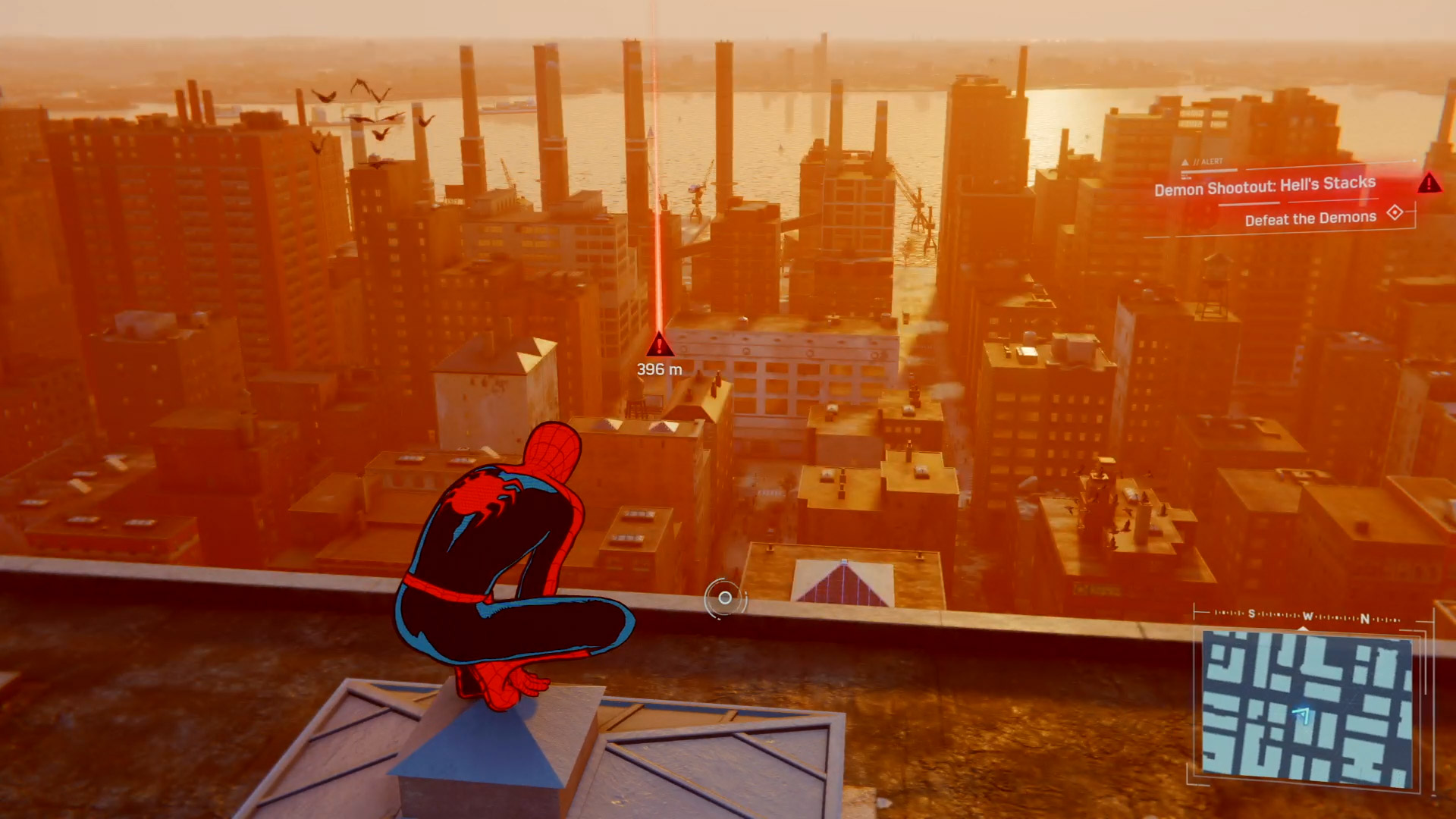Here’s something you probably weren’t expecting - Marvel’s Spider Man left me very perplexed upon completing it.
Source: Insomniac Games
While the graphics are gorgeous and the story is well written and directed, there was just something about it that has been eating away at me the more I've had time to reflect on my 30 hour trek through it. Yes, the combat is frenetic and has a nice learning curve that makes mastering moves satisfying and rewarding. The loop you find yourself in as you swing your way through Manhattan of making your way toward a waypoint, stumbling across a crime in progress or a side objective, fighting up a few bad guys, and then continuing along your way is truly fun. It's also something that I've praised before in a previous article on No Man's Sky for featuring a similar loop and waypoint system. Yet while this gameplay is fun, it's also very formulaic and systemic of other AAA open world games like Assassin's Creed and Far Cry and Horizon: Zero Dawn and… well, you get the idea. However, what separates this specific mold of open-world from other games is the context that it gives you for completing certain generic objectives and finding collectibles.
In the early hours of Spider-Man, once you're given free rein to explore New York, the game introduces two types of collectibles/objectives for you: backpacks and police towers. In other games, you might know these as orbs, watch towers, relics, korok seeds, and so on. For some of these games, these objectives often feel overtly like padding for the sake of filling the world out with something so the player isn't bored traveling between main narrative beats.
Take for instance the Middle Earth series, where in each region you must seek out towers to enable fast travel points and highlight side objectives on the map. There's no real reason why these towers even exist in the game outside of enabling these two gameplay mechanics for the player nor does the game try to create a reason for it. To me this feels like unnecessary busywork for the player to wade through without giving you any sort of contextual reason and thus no proper satisfaction for completing these. However, Spider-Man not only has an explanation for unlocking these towers, it also feels extremely logical when you hear it. This can be said for nearly every side objective in the game - backpacks, Black Cat stakeouts, Research labs, gang hideouts, and so on. Everything that developer Insomniac lays out for the player to do has some sort of narrative background that ultimately ties into the lore of the universe they're building.
Let's go back to the other early game collectible you're told about - backpacks. There are two reasons why this collectible is so fantastic and should be the shining example other games look towards when creating something similar. First, it makes sense why these backpacks would be sprawled across the city. Peter is a young man merely scraping by in New York - early on in the story he's even evicted from his apartment due to his late payments. It makes sense within the universe for Peter to tuck these backpacks away as a means of safety storage for his personal belongings. Along with that, Insomniac has managed to implement a clever way to build the lore of the game - something crucial for a story set 8 years after Peter becomes Spider-Man. Each backpack unlocks a new item in your collectible list. These items can be examined like any other model, and it also unlocks a small piece of dialogue of Peter creating some context as to why these items are important to him.
That's not to say that all of the side objectives within the game are without faults, however. For the first act and roughly most of the way through the second, these additional tasks are introduced in a fairly rhythmic manner. You'll start with the towers, backpacks, Fisk hideouts, and crime alerts for thugs. You'll then be introduced to two research mini-games, Harry Osborn's research labs, and even more hideouts and crime alerts. It is at this point where I quickly started to feel overwhelmed, as I had not even fully gathered my bearings on previous secondary objectives. That's not even the end of optional content there is to explore; once you start Act 3 you're introduced to even more crime alerts and hideouts on top of side missions that are released as you progress through the story.
At that point I almost didn't even want to bother completing anything else. When I originally started collecting backpacks, I was kind of relieved that there was only 55 to gather. Usually when you have a collectible of this sort there's over 100 of them, and towards the end of that the joy of collecting becomes a chore. However I feel that if I'd be given 155 backpacks to collect throughout my course of the game I would have had a better time than being bombarded over and over by crime alerts from four different enemy "types" as you make your way to the next story beat. It came to a point where I actually wanted to utilize the fast travel feature despite originally believing that Insomniac shouldn't have implemented one at all to show confidence in the traversal mechanics they built.
Now I say that I was bombarded by crime alerts while swinging around through New York, I feel like I should clarify this. As you make your way across the city, you'll hear radio chatter from dispatchers and police of ongoing criminal activities. They'll then be highlighted briefly on your screen and disappear if you ignore them. At no point are you forced to do any of these activities if you choose not to. Sure, you may be at combative disadvantage should you choose not to, but it's never a necessity. Much like how I praised No Man's Sky waypoint system in a previous article, Spider-Man implements a similar system which works just as well, if not better for the simple fact that you won't really see any markers unless you press R3.
This design is near perfect, except for the fact that you're also given a mini-map. This map provides no further insight or clarity that you don't already receive while you're staring at your character moving around on screen. The fact that you can't even turn off the map in a settings menu is baffling as well, and something that I feel Insomniac lacked confidence in removing which ultimately hurt my enjoyment of the game. The developer's clearly put a tremendous amount of effort into creating a captivating city, it's frustrating to often become distracted from it.
Despite my negativity towards side content and some HUD elements, I have to give credit where credit's due: Insomniac managed to create a Spider-Man story that rivals most of the film adaptations preceding it. What helps partially with that is forgoing the "origin" narrative told multiple times at this point and jumping 8 years into Parker's run as the costumed hero. The writer's don't spell out everything that has happened in that time span either which aids in making the dialogue and story feel more believable. In one of the game's earlier cutscenes involving Peter and MJ reconnecting with one another, you only receive bits and pieces of what happened to their relationship. At one point, there's even an opportunity for the writers to provide an expository dump on their falling out, but they don't; it's only towards the second act of the campaign when the breakup is naturally brought up in an argument. It's moments like these that give Spider-Man a leg up over other stories not only in gaming, but in film as well.
It's clear that during the majority of Spider-Man's development, Insomniac focused on two key things: the story and gameplay mechanics. Despite how frustrated I became by the tedium erupting from the miscellaneous objectives around New York, I always ended up lost in time. Swinging from building to building, running along walls, skirting the ground to hear the ambient sounds of cars and citizens - it never grew tiresome and always felt fluid. There's not necessarily a lot of skill involved in the swinging unlike in previous entries such as Spider-Man 2, but the fluidity in the superhero's movements combined with the sound effects utilized as you swing helped to make each movement feel rewarding. This isn't too dissimilar to how using the Leviathan Axe in God of War felt, where each toss of the axe to execute a combo not only felt weighty and devastating but also looked and sounded like it.
However, it's when that control of Spider-Man is taken away and replaced with MJ and Miles Morales, the game loses all pacing and momentum as if you were swinging and collided into the side of a building. While it's been noted by Insomniac that these segments, notably MJ's, were created to add more weight and attachment to these characters, I couldn't help but feel the opposite. For all of these segments sans the very one or two of them, you're forced to sneak around an area avoiding villains, and it is never fun nor engaging. While I'm sure the developers intended for these missions to require some time and effort into playing them, I was able to determine enemy paths very quickly and get around very easily in no time at all. There's no real challenge when playing these sections, and there's no real engaging gameplay to be had either. If you're going to replace the mechanics of playing as Spider-Man momentarily for something else, then you have to provide a compelling enough mechanic to distract us. If you don't, all you're doing is frustrating the player with something that they don't want to do.
Source: http://www.shindig.nz/gaming/game-reviews/spider-man-review/
For a brief second, I thought the developer had an interesting idea towards the middle of the game where MJ is being held hostage in Times Central Square, and she can have Spider-Man take out specific enemies while she sneaks her way through. It was interesting to actually have a partner dynamic going on, and it actually made me feel a connection between the two characters.
Spider-Man ultimately boils down to an amazing game slightly strung down by some unfortunate missteps. What can't be denied however is that the team at Insomniac truly strove to create something special, and for the most part I'd say they succeeded. While it doesn't feel as near a total package as God of War did earlier this year, Spider-Man has a solid foundation and enough potential to swing towards even greater heights in an eventual sequel.




